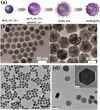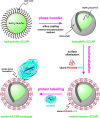Recent progress in the development of upconversion nanomaterials in bioimaging and disease treatment
- PMID: 33121496
- PMCID: PMC7596946
- DOI: 10.1186/s12951-020-00713-3
Recent progress in the development of upconversion nanomaterials in bioimaging and disease treatment
Abstract
Multifunctional lanthanide-based upconversion nanoparticles (UCNPs), which feature efficiently convert low-energy photons into high-energy photons, have attracted considerable attention in the domain of materials science and biomedical applications. Due to their unique photophysical properties, including light-emitting stability, excellent upconversion luminescence efficiency, low autofluorescence, and high detection sensitivity, and high penetration depth in samples, UCNPs have been widely applied in biomedical applications, such as biosensing, imaging and theranostics. In this review, we briefly introduced the major components of UCNPs and the luminescence mechanism. Then, we compared several common design synthesis strategies and presented their advantages and disadvantages. Several examples of the functionalization of UCNPs were given. Next, we detailed their biological applications in bioimaging and disease treatment, particularly drug delivery and photodynamic therapy, including antibacterial photodynamic therapy. Finally, the future practical applications in materials science and biomedical fields, as well as the remaining challenges to UCNPs application, were described. This review provides useful practical information and insights for the research on and application of UCNPs in the field of cancer.
Keywords: Bioimaging; Biomedical applications; Drug delivery; PDT; Upconversion; aPDT.
Conflict of interest statement
The authors declare no conflict of interest.
Figures

















References
-
- Bednarkiewicz A, Prorok K, Pawlyta M, Strek W. Energy migration up-conversion of Tb3+ in Yb3+ and Nd3+ codoped active-core / active-shell NaYF4 colloidal nanoparticles. Chem Mater. 2016;28:2295–2230. doi: 10.1021/acs.chemmater.6b00353. - DOI
Publication types
MeSH terms
Substances
Grants and funding
LinkOut - more resources
Full Text Sources
Medical

